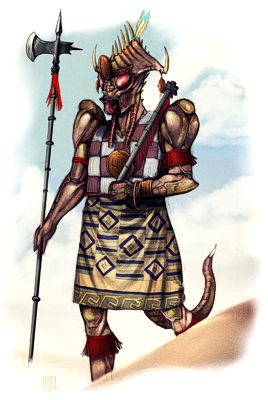

Realmspace

| Climate/Terrain: | Deserts of Anadia |
|---|---|
| Frequency: | Very rare |
| Organization: | Community or family units |
| Activity Cycle: | Day |
| Diet: | Omnivore |
| Intelligence: | Genius (17-18) |
| Treasure: | None |
| Alignment: | Lawful neutral |
| No. Appearing: | 1-4 |
| Armor Class: | 0 |
| Movement: | 15 |
| Hit Dice: | 10 |
| THAC0: | 11 |
| No. of Attacks: | 3 |
| Damage/Attack: | 1d8/1d8/2d6 |
| Special Attacks: | Bleeding |
| Special Defenses: | Nil |
| Magic Resistance: | Nil |
| Size: | L (10’ tall) |
| Morale: | Elite (13-14) |
| XP Value: | 2,000 |
The anadjiin is a vicious predator that originated on the planet Anadia, the first planet in the Realmspace solar system. These creatures appear to be slightly humanoid in shape, but they have very tough reptilian hide which deflects most weapons. The top of the anadjiin head has a spiny crest which looks similar to that of a stegosaurus dinosaur. This crest has an abundance of small capillary blood vessels at the surface which allow the creature to cool off in the hottest of environments. This crest also disables the creature's ability to survive in colder climes.
The anadjiin has two insect-like eyes sitting on the side of the head. This positioning allows the creature to see in a 360-degree arc at all times. The brain of the anadjiin is so complex that it is able to assimilate all the information received as well as react to it.
Its mouth is a bit unusual when compared to those of most other creatures. The mouth sits vertically on the face, instead of horizontally. The teeth are aligned vertically as well, and are very sharp. Once the creature has hold of a victim, there is no way to force the anadjiin to release the grasp, short of killing it. Even then, the jaw must be broken before the hold is released. The chin, instead of being under the mouth, is split in two, with a cleft on either side of the mouth.
The anadjiin has a stout tail which it uses to stabilize itself should it ever be pushed, or lose its balance. The tail is never used as a weapon. Each of the anadjiin's hands is layered with six-inch long claws. It prefers to use these claws as slicing weapons, attacking with each hand every round. The claws act as though they were blades of sharpness. Anyone attacked by them suffers an additional hit point of damage per round per wound until the wounds are bound or healed.
Combat: The anadjiin prefers to hunt during the day, because it cannot see in the dark. It therefore hides and sleeps during the night. When it does attack, the anadjiin uses its speed and agility to gain the initial advantage. If the opponent is alone, it attacks with a bite. If the bite attack is successful, it does not release its hold until the opponent is dead. It flails wildly at the abdomen of prey, hoping to sever the entrails, which quickens the death of the prey.
If there are multiple targets, the anadjiin still uses its bite attack, but it does not hold on. Its genius intelligence knows that stupid fighting like that is the sure way to die. Instead, the anadjiin moves about, attacking mostly one target, usually the weakest, until it falls. At that point, it tries to scare the rest of the targets away, so it can carry its prey back to its lair.
Habitat/Society: The anadjiin is a very caring parent and mate, ready at any time to fight to the death to protect its young. However, in times when food is rare, anadjiin are known to kill and eat their young to keep them from feeling the pain of starvation. Separate family units often work together to find food. They never fight among themselves whenever prey is found. Each realizes the amount of effort put forth, and demands a share equal to that. This relationship, which is quite unique to predators, is one reason that the anadjiin is well respected. Besides their own language, it is unknown whether the anadjiin have the capabilities to speak common or any other language known in the spheres. No one has stayed around long enough to find out.
Ecology: When hunting, the anadjiin is careful to preserve the balance of nature. It never hunts or kills any prey that is rare or endangered. The anadjiin feels a strong bond with nature itself, and feels compelled to hunt only that prey which is most abundant. This explains why the anadjiin hunt humans when they are transported to other planets, but do not hunt humans on Anadia. They do, however, prey on the halflings and umber hulks of Anadia whenever possible, because there are so many of both.
